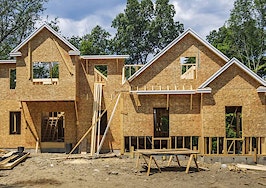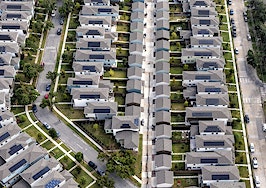The moment has arrived — the moment to take charge. This summer, at Inman Connect Las Vegas, July 30-Aug 1, 2024, experience the complete reinvention of the most important event in real estate. Join your peers and the industry’s best as we shape the future — together. Learn more.
New-home sales improved across the board in January, according to the U.S. Census Bureau and the Department of Housing and Urban Development on Monday.
New-home sales, which include when a homebuyer makes a deposit or signs a sales agreement, increased 1.8 percent year-over-year to a seasonally adjusted rate of 661,000. Sales are also 1.5 percent above December’s revised rate of 651,000.
TAKE THE FEBRUARY INMAN INTEL INDEX SURVEY NOW
Several economists said the boost in new-home sales, albeit minor, signals strengthening buyer resiliency amid elevated mortgage rates. Sales for the segment are expected to remain strong well into the spring buying season, as builders offer an array of incentives, such as rate buy-downs.

Dr. Lisa Sturtevant
“The uptick in new home sales came despite wintery weather in January and reflects the still-strong demand in the market,” Bright MLS Chief Economist Dr. Lisa Sturtevant said in a written statement. “Mortgage rates are still a constraint, as they rose to their highest level since mid-December last week, but homebuilders are still offering to buy down rates or offer other concessions to homebuyers.”
“In the new home market, builders have often been able to offer to buy down a buyer’s mortgage rates, subsidizing the mortgage payment and making it easier for them to get into a home,” she added. “Record profits in recent years have made it possible for builders to offer these concessions.”
RCLCO Real Estate Consulting Principal Kelly Mangold said a lack of existing home inventory will continue to bolster new-home sales for the foreseeable future.

Kelly Mangold
The National Association of Realtors’ January existing-home sales report said the inventory of unsold existing homes is at 1.01 million, which translates to 3.0 months of supply at the current sales pace.
Meanwhile, the inventory for unsold new homes is at 456,000 — 8.3 months of supply at the current sales rate. New homes currently account for 30 percent of total inventory on the market, 20 percent more than the historical average for the segment.
“As fears of a significant recession lessen, buyers who have been sidelined for the past year or more are feeling more confident about making a purchase,” Mangold said in an email to Inman. “With resale inventory remaining tight, the new home market can meet pent-up demand for households seeking space that better meets their needs.”
Although there are plenty of headwinds in the new-home segment, Sturtevant said affordability will be the main question mark for homebuyers. The median price for new homes in January was $420,700; 11 percent higher than the median price for existing homes ($379,800).
“Affordability is a key factor in the market in 2024, with home prices still generally on the rise and mortgage rates remaining elevated,” she said. “In January, the median price of a new home was $420,000, which was up 1.8 percent from December but fell 2.6 percent compared to a year ago. New home prices have declined for five months in a row, [but] new homes are still more expensive than existing homes.”
Sturtevant said homebuilders must continue circumventing elevated mortgage rates and median prices with robust buyer concessions, especially if they want to take advantage of pent-up buyer demand this spring.
“Homebuilders (and homebuyers) were hoping to see mortgage rates fall at the beginning of 2024, but strong economic data has suggested that the Federal Reserve will be delaying interest rate cuts until later in the year, which has kept mortgage rates close to 7 percent,” she said. “Rates will fall later this year, but the timing will depend on labor market conditions, inflation, and the Fed’s decision about when to cut rates and by how much.”
Homebuilders will have to react to the growing affordability concerns by continuing to offer concessions like mortgage rate buy downs, dropping prices, or building smaller homes that can be built at lower cost.”













